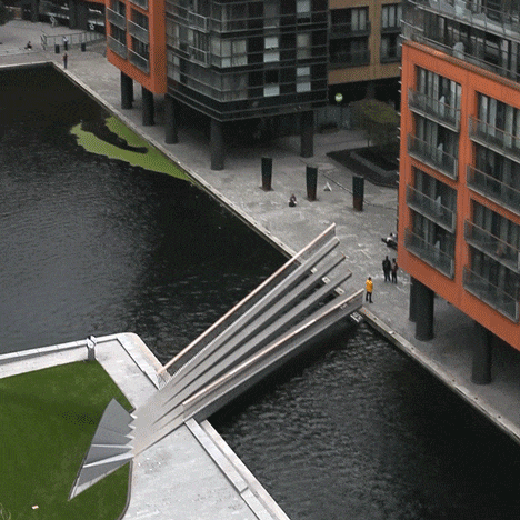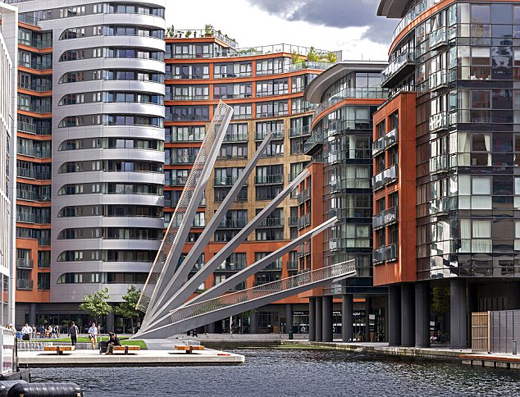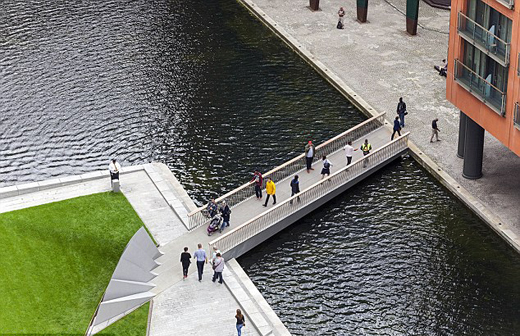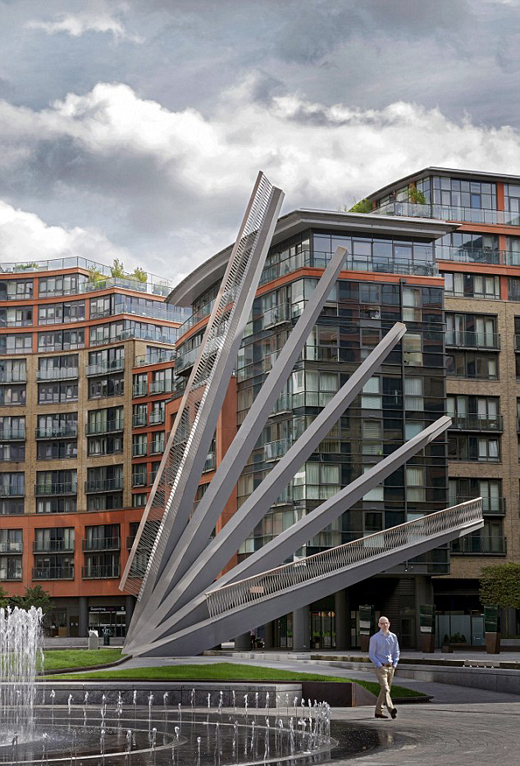FAN-tastic design! Engineers create London footbridge that unfolds like a paper concertina
FAN-tastic design! Engineers create London footbridge that unfolds like a paper concertina
Mangalore Today News Network
London, Oct 25, 2014: One of London’s canal ways has received a Japanese makeover with the opening of the Merchant Square footbridge.
Spanning the capital’s Paddington Basin, the structure looks like a conventional bridge six days of the week.
But come noon on Friday, and it transforms into an incredible fan as it lifts up to let passing boats through the canal.

Every noon on Friday, the bridge transforms into an incredible fan as it lifts up to let boats through the tiny canal
The design uses five steel beams which move using hydraulic jacks to open and close like the blades on a fan.
The bridge spans the 65ft (20 metre) width of the Grand Union Canal in London’s Paddington, close to Thomas Heatherwick’s Rolling Bridge that curls into a ball.
High Wycombe-based design group Knight Architects and structural engineers AKT I won a competition to design a kinetic sculpture and have created the ‘Fan Footbridge’ as result.
The bridge’s five beams, which range from six to seven tonnes, rise to different angles creating a fan effect and are balanced by a 40 tonne counterweight which keeps the beams stable.
High Wycombe-based design group Knight Architects and structural engineers AKT I won a competition to design a kinetic sculpture and have created the ‘Fan Footbridge’ as result
‘Shaped counterweights assist the hydraulic mechanism and reduce the energy required to move the structure,’ said a spokesperson from Knight Architects.
‘The bridge balustrades are formed from twin rows of inclined stainless steel rods, overlapping to form a robust yet filigree and highly transparent structure.’

The bridge will let boats past and, when it is fully closed, pedestrians can walk along the 9.8ft (3 metre) wide new design, which is illuminated by LED lights
 The bridge’s five beams, which range from six to seven tonnes, rise to different angles creating a fan effect and are balanced by a 40 tonne counterweight which keeps the beams stable
The bridge’s five beams, which range from six to seven tonnes, rise to different angles creating a fan effect and are balanced by a 40 tonne counterweight which keeps the beams stable
‘The most challenging part of the fabrication was the required accuracy. For safety reasons, gaps between the beams had to be no bigger than 3mm over a length of 20 metres’, project architect, Bartlomiej Halaczek told Dezeen.
‘As impressive was the fabrication accuracy of the conical counterweights, which sink into the engine room turning into a set of walkable steps flush with the granite slabs around them.’
The bridge will let boats past and, when it is fully closed, pedestrians can walk along the 9.8ft (3 metre) wide new design, which is illuminated by LED lights.
- Mangaluru: Fisherman slips into well; dies
- Huge tree falls on road at Balmatta; vehicles damaged
- Udupi: Elderly man defrauded of ₹49 lakh in stock market scam
- Milk producers union seeks price hike to sustain dairy farmers in DK, Udupi
- Mangaluru: Young Yakshagana artiste dies in road mishap at Arkula
- Cops welcome New Year by distributing cake to motorists
- Mangaluru / Udupi rings in New Year with festive spirit and grand celebrations
- Ullal: Rider dies as lorry collides with two-wheeler
- EPFO, UPI, GST and Visa: These things will change starting January 1, 2025
- Man sentenced to death for murder of his three children
- Mangaluru street food festival from January 18 to 22
- Wish you all a Wonderful New Year
- Puttur: Womanʼs leg gets stuck in broken drainage pipe; rescued
- Terrifying prediction for 2025 made by Baba Vanga and Nostradamus, seem the same
- Manmohan Singh (1932 - 2024): a Reformer and Gentleman PM
- Woman married 6 men, fled with cash, jewels, arrested in 7th attempt
- AAP uses AI to create "Santa Kejriwal" avatar in christmas greetings
- Video: 17-feet-long Python, weighing nearly 100 kg, found in Assam
- Srijana stood by him: Bibek’s love story moves internet as influencer succumbs to cancer
- Bengaluru school locks students in dark room over unpaid fees
- ’Perfectly spherical’ Egg sold for Rs 21,000 in UK
- Shashi Tharoor’s old friend Soros post from 2009 goes viral. He reacts
- This Indian chocolate won gold at the prestigious International Chocolate Awards 2024
- Rs 2,000 ki plate: This honest wedding invitation card takes internet by storm
- Japanese man creates imaginary girlfriend using wig and props, stuns internet
- Here is Raven: This bird-inspired drone can walk, hop and jump for take-off
- Defence Ministry declares 2025 as ’year of reforms’
- Karnataka rings in peaceful New Year, says Home Minister Parameshwara
- 8 Pakistanis, caught with 232-kg drugs off Gujarat coast, jailed for 20 years
- Honnavar: Tragic road accident claims three young lives
- Mumbai hoarding collapse: After 7 months, key accused arrested from Lucknow
- PF case: Karnataka HC stays arrest warrant against former cricketer Robin Uthappa
- Happy New Year 2025: President Droupadi Murmu, PM Modi extend New Year greetings
- Man kills mother, 4 sisters over family dispute at Lucknow hotel on New Year
- Hubballi gas cylinder blast: Death toll reaches 8
- Telangana thief robs liquor shop, drinks on the job, gets arrested
- Railway officer in Bengaluru arrested for taking Rs.50 lac bribe to help candidates pass KAS exam
- ISRO’s GSLV mission in January will be 100th launch from Sriharikota
- CITY INFORMATION
- TRAVEL
- TOURIST INFORMATION
- HEALTH CARE
- MISCELLANEOUS




 Write Comment
Write Comment E-Mail
E-Mail Facebook
Facebook Twitter
Twitter  Print
Print 


